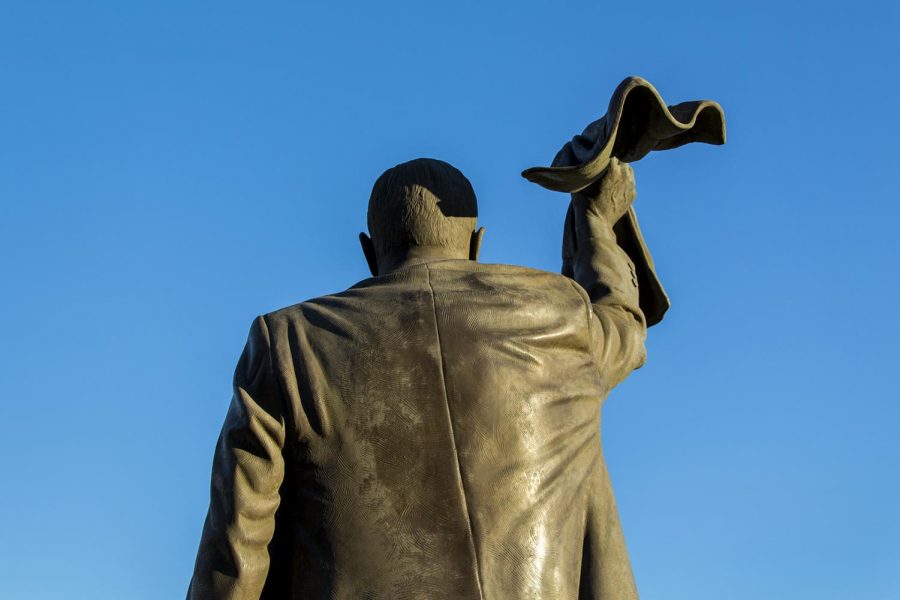Sculpting a campus: Meet the alum behind campus landmarks
November 26, 2017
From Guthrie’s statue at the base of the clock tower to Coach Diddle in front of the arena to the massive statue of Big Red in DSU – most students at WKU are very familiar with Russell Faxon’s work, even if they do not realize it.
Faxon is a renowned bronze sculptor from Bowling Green and a WKU alum. He’s been commissioned over the years for numerous pieces on campus, mostly statues of notable figures at WKU.
“Gary Ransdell contacted me about doing some work, and it just kept on building,” said Faxon. “Now I have many pieces up there at Western. It’s really good to be represented by your alma mater and be able to do work for them.”
A class on claywork in Bowling Green High School sparked Faxon’s desire to professionally pursue art, but he ended up going to Memphis State University briefly on a football scholarship. After a brief period, he decided it wasn’t for him. He transferred to WKU and began studying art.
He spoke highly of the arts department at WKU as a whole for its sense of community and what he learned through it. Charles Forrester, a Sculpture Professor at WKU from 1965 to 1992, taught Faxon. He said he adapted the coursework, working with him to be sure he got what he wanted and needed out of his education.
“When I’d go in and give him my ideas and thoughts, he would just say, ‘Well let’s get started! What are you talking to me for? Go out there and start doing it!’ He gave me a lot of leeway in what I wanted to do with my sculptures,” Faxon said. “I’m grateful to him, and the art department as a whole just had a lot of camaraderie.”
Faxon graduated from WKU in 1973 with a bachelors degree in Art Education. He worked in Nashville for two years as a teacher, until he decided to continue his studies in sculpting. He traveled to Pietrasanta, Italy, which is noted for its bronze foundries and marble and spent time learning there.
He chose bronze as a medium due to its rich and lasting quality.
“It’ll endure longer than we’ll be around, that’s for sure. It just has a richness that no other medium has. It’s just rich and enduring. And it takes on it’s own qualities over time. It’s very appealing to me.”
When a piece is commissioned, Faxon begins the process by modelling it in clay. A rubber mold is made of the clay work. Wax is then poured into the rubber mold. The wax is broken into multiple sections and then coated in ceramic. The wax is melted out of the mold, giving a clean ceramic shell in which molten bronze is poured. This process is referred to as lost-wax casting.
The shell mold is broken off the bronze, and the pieces are welded together. Jody Richards, for example, is composed of nine pieces. Craftsmen at the bronze foundry smooth them together, replicating the textures to give it a seamless finish. The process in all takes around nine months to complete.
He puts great detail into each of his pieces, drawing from knowledge about the individual and their personality for the work. For example, Sgt. 1st Class Robert Guthrie, who was killed during the Korean war, is adorned with small details such as the American flag in his hand, and the Eagle Scout sash coming out from his duffel bag.
“The design is such that he’s looking back to his home, but he’s stepping forward to a fate where he has no concept of what’s going to happen,” said Faxon. “It’s just those small little things that wind up representing who that individual was.”
In 2012, Faxon was inducted into WKU’s Hall of Distinguished Alumni, which he described as a true honor. His works on campus include Robert Guthrie at the Guthrie Bell Tower, Coach Diddle at Diddle Arena, Big Red at DSU, Lee Robertson at the Augenstein Alumni Center, Big Red by the Augenstein Alumni Center and most recently, Jody Richards at Jody Richards Hall.
Faxon lives in Bell Buckle, Tennessee, where he works in Selah Studio, as well as in serving as the resident artist in the Webb school.
Reporter SarahBeth Davis can be reached at [email protected].













